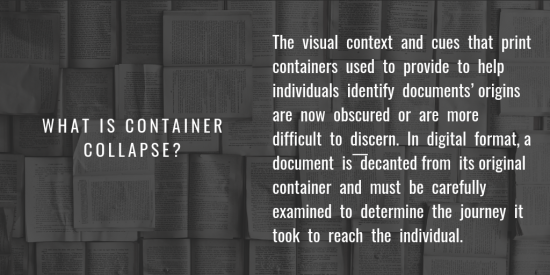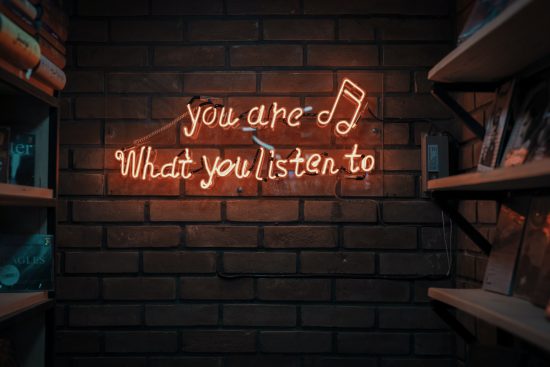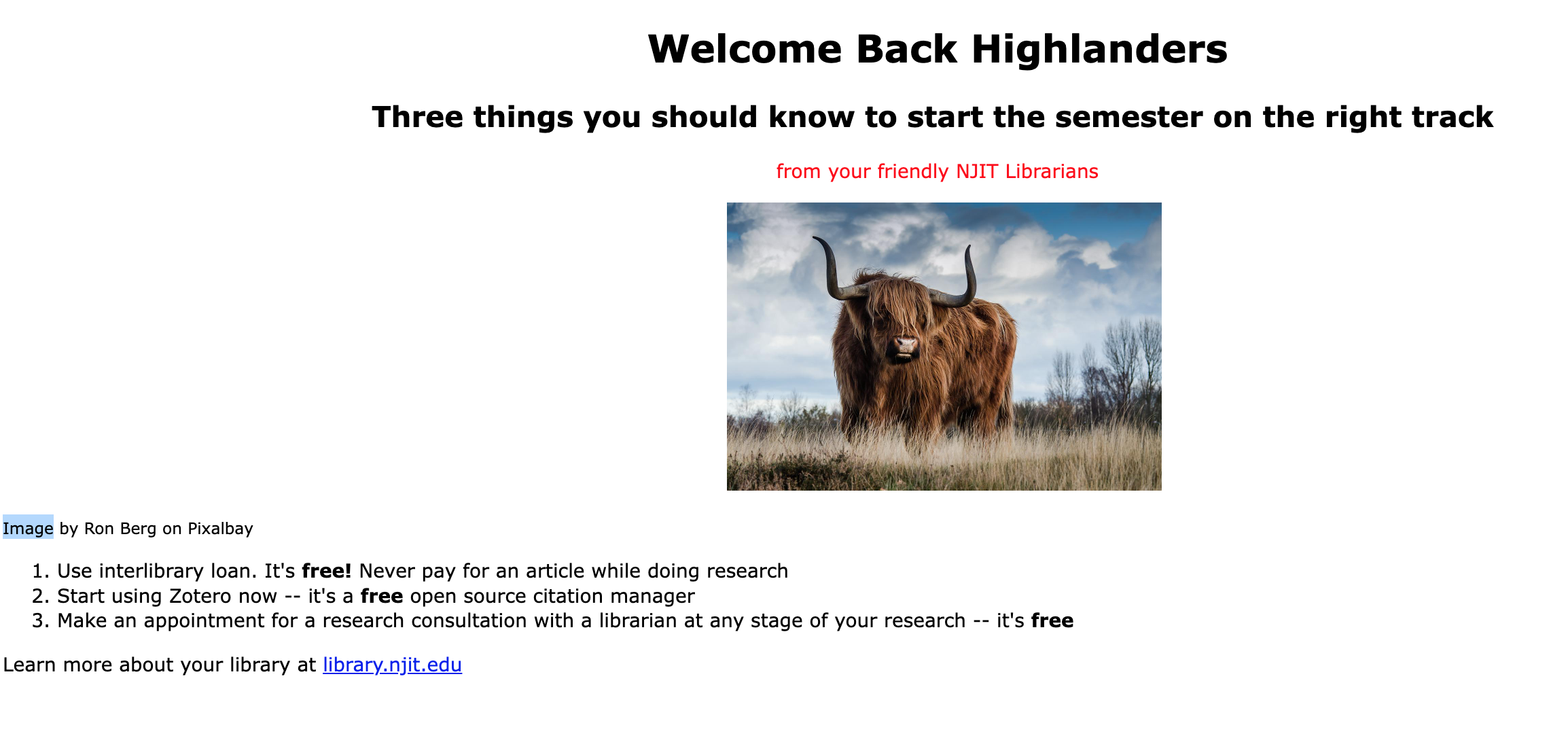Gentle reader, I created a little video for my fellow instructional design classmates with whom I’ve been on a journey of discovery on the many topics discussed herein.
Thanks for the memories y’all!
Let's talk librarianship and blogs and accessibility
Gentle reader, I created a little video for my fellow instructional design classmates with whom I’ve been on a journey of discovery on the many topics discussed herein.
Thanks for the memories y’all!
Gentle reader, we’re already at our tenth blog post!

Help me celebrate by checking out a resource I created on a theme that’s been running throughout my blogging careeer: Accessibility.
Take a look at “LibGuides for All” — it’s a site I created to help folks get started in creating accessible LibGuides.
I think that switching how you do stuff at work in your professional practice, as an individual but especially as a group, can be a little overwhelming and stressful. So, I collected some introductory material on digital accessibility, especially as it pertains to larger social questions in academia and STEM and college, and also created some how-to videos. I’m hoping this website can be used in conjunction with an in-house workshop on creating accessible LibGuides.
I asked for some feedback from colleagues and they were all for changing our practice to include digital accessibility. However, there was some reluctance in spending time on it without a directive from on high. I think I need to emphasize the fact that these are habits not big huge new ways of mind-altering change.
What has your experience been with professionals and whether they are willingness to incorporate small changes such as those found in LibGuides for All?
Please let me know what you think of LibGuides for All. You know me by now — I love your feedback.
All of this thinking about evaluating resources has inspired me to create a module — Evaluating Resources. It serves as an introduction to types of resources and how to evaluate them for first year college students.
I love teaching information literacy to first year college students. They are so passionate and their topics show great concern: safety of self-driving cars, LGBTQ sex ed, anti-vaxxers, the environment. They are often focused on WHY something is going on. It’s my job to help them focus their topic into a paper that takes the form of an argument on how to go about things better in this world and to use supporting evidence. Hence my module on evaluating sources.
A few posts ago, I asked your thoughts on Loom and Animoto. Now I’d like to know if anyone out there has used Kaltura. I used Loom for this module but am extremely disappointed by their not providing captions in the “freemium” version — so I added a transcript to my Evaluating Resources module instead of providing captions. But I’d prefer to provide captions! Kaltura provides captions but I don’t like the way you can’t control the “picture in picture” function easily. Then there’s the fact that Adobe Express — which I used to create the module — doesn’t make it easy to embed a video unless it’s an Adobe-created thing.
Enough with the whining.
What should I do about making my screen cast accessible with captions? Talk to me.
Please give me some feedback on Evaluating Resources — I’m all about the improvement-through-feedback thing.
Gentle reader…of late, some thoughts have weighed heavily on this librarian’s soul. I’ve always had a hard time wrapping my head around how to teach first year students how to evaluate resources.
I don’t want to feel like I’m giving heavy-handed advice and I don’t want to feel like I’m providing some binary philosophical system on
WHO TO TRUST
I’ve become quite curious about how the 2016 election and its relationship with fake news and social media has affected how librarians teach information literacy. Read more about it in the preprint Post-Facts: Information Literacy and Authority after the 2016 Election and Why Libraries Can’t Fight Fake News.

Also, I’ve been slowly digesting the findings from the big longitudinal study Researching Students Information Choices (RSIC). This research has coined the term “Container Collapse” — What happens when you “decant” information from its original container (book, journal, newspaper) and turn it into a document in a database that looks like all the others? You get container collapse. Can students recognize these different types of resources? Do these different types of documents matter anymore? The research suggests that heuristics (cues to interpret) don’t help all that much and that deep engagement is needed to evaluate sources.
Many students have been taught to evaluate resources using normative heuristics like “is it a .org or a .com?” I wonder if too great of a focus on these simplistic shortcuts has led to a lesser engagement with evaluation of resources.
The CRAAP test has long been used as a way to evaluate sources. However, it can be a bit overwhelming to some students, so they just don’t bother doing it despite its very fun scatalogical name. SIFT takes a more realistic approach and has students take a gander at the source of the document as a primary way to evaluate its worthiness. SIFT is the new CRAAP.
STOP
INVESTIGATE THE SOURCE
FIND TRUSTED COVERAGE
TRACE BACK TO THE ORIGINAL
Curious about SIFT? Learn more from this SMSU LibGuide on the SIFT Process
For the youngsters out there: Did the 2016 election have an effect on how you were taught to evaluate sources?
For the more “seasoned”: Did the 2016 election have an effect on your teaching of this skill? Or did it have an effect on how your librarian friends talked about it?
Gentle reader, I’d like to know.

(Please suggest a better name. This is a working title.)
This is a new podcast by a librarian and for librarians, but I’ll try to keep it interesting for everyone. I’m going to try to cover all the things that I myself appreciate about a podcast.
Most importantly, I’m going to provide a service – we all have problems keeping up with our professional reading. So I’m going to tell you the good stuff about an article in my podcast episodes and in the next episode, I’ll interview the author of the article to make it more of a dialog and conversation for you, gentle listener.
I like the idea of connecting people with the same interests with this podcast. My first podcast will have an audience of one = me. My second an audience of two which will consist of me and the person I interview. Perhaps the person I interview will then listen to the third. I’m going to accrete an audience.
The first pilot podcast, however, is just me. I hope you enjoy it! I created it with “Voice Memo” on my 2013 MacBook Pro. I wanted to see if the sound quality was good enough — I think it was. Tell me if you agree.
Here’s a handy transcript of my spoken words: Jill’s Journal Club Transcript 42422

Gentle reader, I’ve been thinking of late about coding. Lots of hip young librarians seem to be doing it. But why?
I learned Basic when I was young. I created an adventure game on my Texas Instruments computer as a girl. I know my way around Unix. I can make a really bad SQL database. But that’s about it.
When I was a librarian at a prestigious university in the northern parts of Manhattan, a student was working on a research study. She wanted to show that students just starting out in computer science in college were at a disadvantage compared to students who already possessed some programming knowledge and skills. She seemed to be on to something.
Now my kid, who’s 8, is learning some coding principles in his library sessions at school.
There’s only so much time in the day. Is learning coding a worthwhile endeavor? What does it even mean? Let’s turn to some voices in the educational world to give us something to chew on.
I found some great examples on Edutopia about teachers who go to great lengths to teach students coding. But I also stumbled across The Future of Coding in Schools, an interesting article by Resnick, the creator of Scratch (a kid’s free coding platform developed by Resnick at MIT). Resnick would like all students to learn to program. However, not for the reasons you might think — not just to gain skills to get jobs, but to learn to “organize, express and share ideas in new ways.” We teach everyone to write for this reason — why not teach everyone to code for this reason.
On the other hand is it just another “silly fad” as Margaret Wente puts it in an opinion piece entitled Coding for Kids: Another Silly Fad in the Globe and Mail. We should not be teaching coding at the expense of math and science which help us to understand the real world. Digital literacy skills are far more important to stress because they are more useful to more people.
Derek Newton, in a Forbes article, says “The way we teach kids to code may be wrong.” Coding requires a certain mindset that should focus not just on the digital experience. Coding isn’t approached as a “skill” in the earlier grades. It’s about building a foundation that can be used to learn coding skills later on. Tactile learning with real objects may be a better way to teach the concepts that will be needed to build future learning.
Three perspectives — all interested in foundational learning — but with different approaches.
Any sufficiently advanced technology is indistinguishable from magic.
Arthur C. Clarke
At the very least, it is important for any citizen to have some understanding of what goes into making computers work, IMHO. Algorithms are increasingly shown to be biased. Technology is increasingly important for getting jobs. Conspiracy theories abound surrounding technologies. A well-informed citizenry should be able to evaluate and understand the tools they need to use every day at least from a consumer perspective. That’s my two cents worth. How to go about it and what everyone should know as a baseline…that’s a knotty question.
Librarians are definitely concerned with “data literacy.” Is coding important as well? As a higher education librarian, what can I do to support coding in college? Do we need to use digital tools to create or learn to create digital tools? What’s more important — digital literacy or coding?
I decided to dust off my HTML skills.
I’m sure you’re wondering “why?”
Because sometimes it’s good to understand how my digital content looks “under the hood.” Screen readers don’t read in a linear fashion. They don’t read content from beginning to end. When you think about it — you don’t do this when you look at a webpage. You use the navigation cues like tables of contents, lists, links, etc. to decide what’s important to read.
Screen readers use HTML “hypertext markup language” to help the user navigate by reading certain parts of the website first like the headers and links and other navigational features. HTML is also the instructions that a browser uses to display your webpage. HTML structures content — browsers and screen readers use these structures in their own ways to help the user navigate.
Take a look at what I made:
Be kind in your judgment!
As i created it, I sometimes used the WYSIWYG editor when I wasn’t familiar with an HTML tag I needed to use (such as resizing the image). As I used the WYSIWYG, I saw that it sometimes misinterpreted what I wanted to do. For instance, it added <h2> tags to stuff I didn’t want to be in the heading. This would have confused the screen reader.
I also feel happy about the HTML5 community on the web. I decided to add a caption to my image. I googled and found many forums of happy HTML5 users who had shared how to do just this with the <figcaption> tag. I also rediscovered the <small> tag.
What’s the moral of the story? Maybe you don’t need to code with HTML — but you do need to know how to edit with it.
I created a video — LibGuides for All.
Tell me what you think of it! It is meant to be a little feel-good introductory video to a website I’m designing for my colleagues to launch a project to make our LibGuides more accessible.
I used Animoto. I’m not sure what I think of Animoto. I have been using Loom a lot for screencasting when creating instructional materials. So, I thought I had better try out a new tool. I am trying to think of why I’d want to use Animoto over Loom. Animoto seems good for stuff you want to try to market. Or perhaps it would be a good way to get someone’s attention at the beginning of a class. Perhaps it would be best for introducing an idea. I just can’t seem to wrap my head around using it for anything in-depth. Loom seems a bit more personal and I have more control over the pacing and the layout of the slides I’m voicing over. I may just need to play with it a little more…
I think for the website I’ll end up using Loom after all.
Gentle reader, which do you like better — Loom or Animoto?
Have you used Animoto for anything more than an introductory material?
P.S. Also, I inserted the “add source” text box for the images I grabbed from unsplash. However, I don’t really see them. Do you? What’s up with that?
Here are the sources for the images — just so they’re acknowledged somewhere!
Photo by Mike Kiev on Unsplash
Photo by Florian Klauer on Unsplash
Photo by Daniel Ali on Unsplash
Photo by Liam Briese on Unsplash
First of all, I’d like to give a shoutout to the various creators of the “undo” concept in personal computing — I learned from the Wikipedia article about the history of the “undo” concept that there are multiple inventors of this very important tool. Without it, this week’s blog efforts would have resulted in many many tears. I have created a stunning new banner for this blog! I will share my journey and what I’ve learned along the way.
It is so very easy to find really amazing images on the internet. It is just as easy to copy them and re-use them. But should you re-use just any image? No, gentle reader, you should not. Many are under copyright and it would be illegal to use them as well as just not nice.
But dismay not, there are many sources of images that you can use. I’m going to share with you my ultimate favorite — the NASA Image Library. Images created by NASA are free to use for many purposes. There is often a suggested attribution phrase. In this case it is imply “Credit: NASA.”
See Media Usage Guidelines to learn more about using NASA images.
Your taxpayer dollars have paid untold millions to create spacecraft such as the Hubble Space Telescope and the recently launched James Webb Space Telescope. You can personally reap the benefits of space research by using the incredible images that inspire us whenever we see them — even printed on a Tshirt at Target.
The Hubble Deep Field is an image I have chosen to use for the background of this blog’s banner. It tells an amazing story. Bob Williams, once director of the Space Telescope Science Institute, decided to point the Hubble at a tiny dark part of the sky where no astronomical objects had ever been observed. What did he find? More than 10,000 galaxies! Read more about The Hubble Deep Fields on hubblesite.org
After you have identified images that you may use, either freely or with permission, it is a good idea to acknowledge the person or machine that created the image. A lot of hard work went into it, after all. Creative Commons Licenses will tell you exactly how the author would like to be acknowledged. A simple cut and paste of the text into your digital creation is easy and will surely give you some good karma.
Learn more about attributions in About the Licenses from the Creative Commons organization.
Our fearless leader has made a suggestion that I never thought I would follow — use a photo you have taken yourself! I decided to use a personal photo which is sadly getting older by the minute but is still one of my favorite photos of myself. It’s me at the IFLA conference in 2010. I was lucky enough to present a paper there: Measuring the impact of the Hubble Space Telescope.
There are some good “freemium” internet tools for amateur image wranglers such as myself. I chose PixlrX. I recommend it highly especially because it has a very forgiving “undo button.” I have used Canva in the past and appreciate its ease of use and ability to make a quick flyer or poster. I thought Pixlr was easier to use to combine images and photographs and resize stuff. I made a lot lot lot of ugly and bizarre banners before settling on the one that’s up there now.
What did I do with PixlrX?
Gentle reader, I added a caption to my image but I just don’t see it. Do you? Have you been able to add a caption to your blog banner image? Were you successful? It should say “Credit NASA”. TIA for any suggestions.
“There is access and then there is accessibility” is a phrase used by C. Booth in “Why Accessibility?” authored for the American Library Association. This may sound like a Jane Austen title, but, in fact, it’s a clever way to show the distinction between access and accessibility.
Creating accessible materials is important for everyone. Let’s take that for granted. However, it’s important to ask about science’s particular relationship with accessibility. According to an article in Nature, ableist cultures in science have made it harder for science people to declare a disability. This means that there are more science people with disabilities than we know of. This is in keeping with a National Academies report that shows a predominant attitude in STEM that “innate talent” is the key to success in STEM fields.
Knowing this helps me to realize that it is more important than ever to create accessible materials in my role as a science librarian.
As a librarian who has worked with science and engineering materials, I can tell you that there is a challenge to creating and maintaining accessible information. I think there are two fronts to the battle:
In this post, I’ll talk about Librarian created material.
Over the past few weeks, I’ve been working to update Research Guides at my temping gig. Research Guides are online pathfinders created to help students learn the best sources to find books and articles for their research papers.
What have I found?
I don’t want to sound like I’m just complaining — these guides are rich with very good content. The access is there. Just not the accessibility. I’ve also found that revising and remediating for accessibility has improved them in so many ways that will benefit everyone. I’ve been chanting the W3.org mantra “Essential for some, useful for all.”
I’ll roll up my sleeves and get back to work on it!
Gentle reader, I ask you to comment on this:
Have you ever introduced the concepts and practice of accessible design to fellow colleagues? If so, were you met with any negative reactions? Did they ease over time? When I first was introduced to these concepts, I will admit that I encountered a mix of emotions: overwhelmed and guilty as well as motivated to change the way I work. I think it’s important to realize that it may take a little time to adjust to these ideas. What has been your experience?